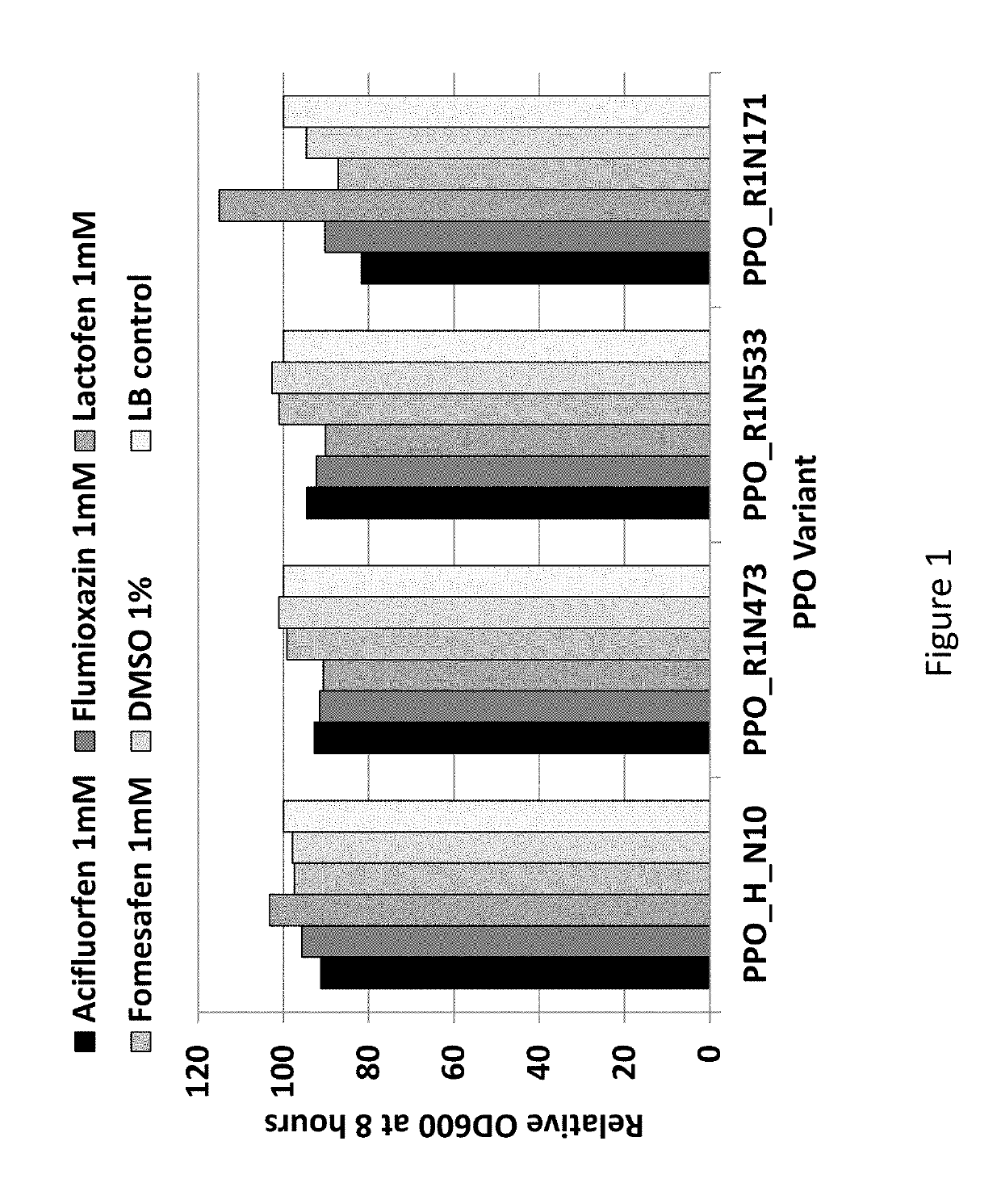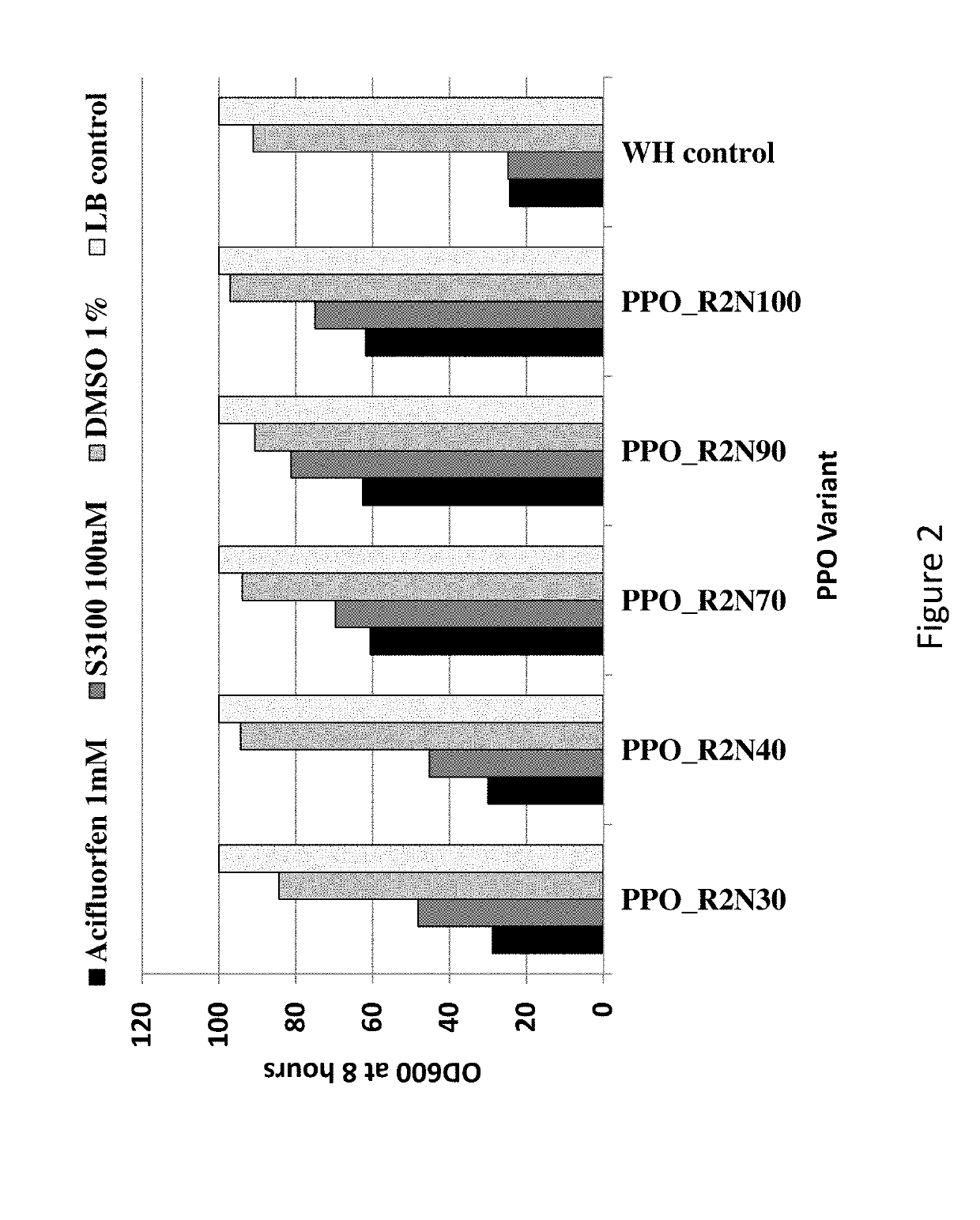Methods and compositions for herbicide tolerance in plants
a technology of herbicide tolerance and composition, applied in the field of biotechnology, can solve the problems that the ippo-recombinant transgenic crop plant has yet to be commercialized, and achieve the effect of reducing the development of herbicide-tolerant weeds
- Summary
- Abstract
- Description
- Claims
- Application Information
AI Technical Summary
Benefits of technology
Problems solved by technology
Method used
Image
Examples
example 1
Protoporphyrinogen Oxidase Discovery
[0087]Novel protoporphyrinogen oxidases were identified from microbial sequence databases using bioinformatic methods and a novel protoporphyrinogen oxidase bacterial screening system. Three sequences representing a diverse range of HemY microbial protoporphyrinogen oxidases and the sequence for the PPO herbicide sensitive HemY protoporphyrinogen oxidase from Arabidopsis thaliana were used to identify new putative protoporphyrinogen oxidase sequences from microbial sequence databases. The use of these four diverse sequences with bioinformatic tools permitted skewing of search results toward sequences that are more similar to microbial protoporphyrinogen oxidases than plant protoporphyrinogen oxidases in order to increase the likelihood of identifying PPO herbicide tolerant protoporphyrinogen oxidases.
[0088]Ninety-nine putative protoporphyrinogen oxidases of the HemY PPO family were identified using this method. The sequences encoding these putativ...
example 2
hyrinogen Oxidase Inhibitor Insensitivity
[0092]Novel protoporphyrinogen oxidases that are tolerant to PPO herbicides were identified using an herbicide bacterial screening system. This screening system used a growth assay of the hemG knockout E. coli strain in LB liquid media supplemented with a PPO herbicide to identify protoporphyrinogen oxidases that were not sensitive to the PPO herbicide.
[0093]The hemG knockout E. coli strain was transformed with the bacterial expression vectors containing the confirmed protoporphyrinogen oxidases and cultured in LB liquid media. A saturating amount of the purified crystalline form of one of five different PPO herbicides (acifluorfen, flumioxazin, lactofen, fomesafen, and S-3100), representing three different PPO chemistry subclasses, was added to the media. Recombinant proteins were expressed and the E. coli growth rates were measured. Growth curves (OD600) were measured for the different variants in the presence and absence of the PPO herbici...
example 3
hyrinogen Oxidase (PPO) Enzyme Assay
[0095]Novel protoporphyrinogen oxidases were characterized using an enzyme assay. This assay used recombinant HemY PPO proteins with plant plastid extract and PPO substrate to identify protoporphyrinogen oxidases that had activity in the presence of a PPO herbicide.
[0096]Plant plastid extract was produced used etioplasts and chloroplasts that were prepared from etiolated cotyledons (soybean, Glycine max), etiolated leaves / coleoptiles (corn, Zea mays) and unfolded apical leaves (A. tuberculatus) generally by the procedure described by Grossmann (2010). Soybean (A3555) and corn (LH244) seeds were placed between two sheets of moist germination paper (Anchor Paper Company, Saint Paul, Minn.) in a beaker of water in continuous darkness for eight to ten days. A. tuberculatus plants were grown for 30 days in the greenhouse. Tissue was collected, placed between moist sheets of paper towels and ground to fine powder with a mortar and pestle in liquid nitro...
PUM
| Property | Measurement | Unit |
|---|---|---|
| weight | aaaaa | aaaaa |
| pH | aaaaa | aaaaa |
| pH | aaaaa | aaaaa |
Abstract
Description
Claims
Application Information
 Login to View More
Login to View More - R&D
- Intellectual Property
- Life Sciences
- Materials
- Tech Scout
- Unparalleled Data Quality
- Higher Quality Content
- 60% Fewer Hallucinations
Browse by: Latest US Patents, China's latest patents, Technical Efficacy Thesaurus, Application Domain, Technology Topic, Popular Technical Reports.
© 2025 PatSnap. All rights reserved.Legal|Privacy policy|Modern Slavery Act Transparency Statement|Sitemap|About US| Contact US: help@patsnap.com


